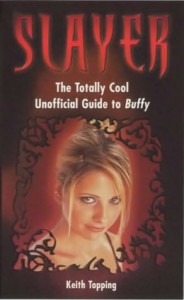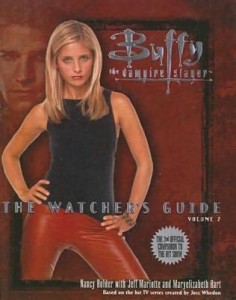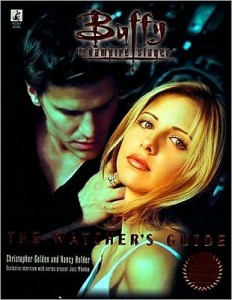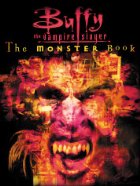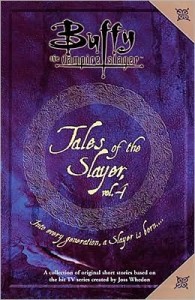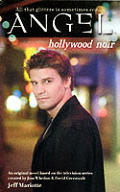Angel: Hollywood Noir, by Jeff Mariotte (Pocket Books, 2001)
Buffy The Vampire Slayer: Spike and Dru: Pretty Maids All In A Row, by Christopher Golden (Pocket, 2000)
Buffy The Vampire Slayer: Tales of the Slayer (Pocket, 2001)
Buffy The Vampire Slayer: The Monster Book, by Christopher Golden, Stephen R. Bissette and Thomas E. Sniegoski (Pocket, 2000)
Buffy The Vampire Slayer: The Watcher’s Guide Volume 1, by Christopher Golden, Nancy Holder, and Keith R.A. Decandido (Pocket, 1998)
Buffy The Vampire Slayer: The Watcher’s Guide Volume 2, by Nancy Holder, Jeff Mariotte, and Maryelizabeth Hart (Pocket, 2000)
Slayer: The Totally Cool Unofficial Guide to Buffy, by Keith Topping (Virgin Publishing, 2000)
Into each generation, a Slayer is born…
Anyone who’s been paying enough attention over the past six or so years is at least somewhat familiar with the cult phenomenon that is Buffy The Vampire Slayer, the hit television show featuring Buffy Summers, a nice, normal everyday average Californian blonde who discovered that her true destiny was to slay vampires. And demons, and giant lizards, and monsters… In fact, it seems like every week, she’s saving the world from yet another threat. Luckily, Buffy’s picked up a few friends along the way to make life easier, and to back her up when things get rough. Over the years, the group’s members have come and gone, but the core membership remains generally stable. Rupert Giles, British-born librarian with a tweed exterior and a dark past, serves as her Watcher, part of an ancient Council sworn to watch over any and all of the constant lineage of teenage girls destined to fight back the darkness. (Why teenage girls? Why not football players, or Bruce Campbell? I’ve always wondered who in their right mind would entrust the fate of the world to a teenage anything…) Willow Rosenberg, computer genius turned powerful Wiccan spellcaster, and Xander Harris, the slighty goofy everyman of the group, back Buffy up constantly, never far behind her. Other members of what has affectionately been dubbed “the Scooby Gang” or “the Slayerettes” have included Kendra, a foreign Slayer doomed to fall in battle; Anya, an ex-vengeance demon; Tara, a quiet witch with a dark family secret; Faith, the rogue Slayer; Angel, the only vampire with a soul, and the only man Buffy’s ever truly love; Riley Finn, college student by day, military agent by night; Oz, the quiet-spoken werewolf; Cordelia Chase, vapid, vacuous, sharp-tongued social ruler of Sunnydale High; Jenny Callendar, computer teacher with a dangerous connection to Angel; and Spike, bloodthirsty vampire whose life has become irrevocably intertwined with the gang.
They’ve fought everything under the sun, and some things that certainly never saw the sun. They’ve survived just about everything the supernatural could throw at them, and come back for more. They’ve survived high school, and moved on into college and the real world. They’ve experienced love and heartbreak, and gone through all the teen angst anyone could ever ask for. The plot twists that have been a hallmark of the show would take a much longer article than this to discuss, so we’ll skip over them, save to note that in the fifth season, Buffy’s younger sister was magically “retconned” into the show. Never mind that she never even existed until then, suffice it to say that she was there afterwards. Also, after the third season, the show produced a spinoff, Angel, starring the so-named vampire with a soul and several of the other characters previously seen in Buffy.
What we’ll do today is take a look at some of the numerous books about and starring the Buffyverse’s characters and situations, as well as those that explore the rich depth of mythological and folkloric tradition that the show draws upon. Three of the books are authorized companions, one is an unauthorized companion piece, and the last three are all examples taken from the various fiction lines inspired by Buffy and Angel.
First up, The Monster Book. Like your critters? Love the monster-of-the-week? This book’s got them all. Expanding and exploring the role of monsters are foils, antagonists, and themes for the show, it goes into rich detail about the wheres and hows and whats of the various beasties and boggarts the Scooby Gang has faced over the years. While a good portion is, quite naturally, given over to vampires and their historical and literary presence, there’s quite a lot of detail given to monsters falling into the categories of demons, ghosts, magic users, primals, the walking dead, invisible people, and the human monster. Tons of pictures, plenty of quotes pulled from the show, and lengthy essays on the subject matter provide hours of fun. We have discussions on the dozens of different races of demons the show has portrayed, possessed ventriloquist dolls, computer-inhabiting demons, evil clowns, boogeymen, ancient mummies, Frankensteinian monsters, zombies, werewolves, hyena spirits, giant snake gods, and so on and so forth. With over three hundred pages devoted to the topic of everything bad you could ever not want to face in a dark alley, The Monster Book makes great bedside reading. While the book gives traditional monsters their due, it also puts a lot of emphasis on the unique Buffyverse twists that have been incorporated into many of the featured creatures. This is certainly no Katherine Briggs book, but it does transcend its existence as a media tie-in to amuse and enlighten.
Next, we have The Watcher’s Guide, Volume One. Covering the first two seasons of Buffy, it’s an in-depth look at the cast and crew and the making and creating of the show from the insider’s point of view. It delves into the show’s mythology, starting with the simple question, “Who and what is a Slayer?” and answers that question in lurid detail, backed up by dozens of quotes taken from the show. It then goes on to discuss the “rules of the game” as according to Buffy, and take us on a stalking tour of Sunnydale, the mythical Californian city that’s home to Buffy and her friends, and a charming little thing called the Hellmouth, part of the reason for all the weird occurences that take place in the vicinity. After a character guide to familiarize ourselves with the main characters from the first two seasons, it goes into a deeper analysis and synopsis of each episode. Then it takes a brief look at the assorted monsters, a topic covered in much more depth in The Monster Book, cheerfully examines the hookups and breakups that mark love in the Buffyverse, and finishes off with extensive cast and crew biographies and interviews. As a reference guide to the television show, it does its job admirably, and acts both as a companion piece, and entry-level introduction to the show for newcomers. However, its existence -is- that of a media tie-in, and owes its existence to the show. The authors are to be commended for putting out such a good volume, and making it able to stand on its own.
The Watcher’s Guide, Volume Two picks up where the first left off, and covers Seasons Three and Four in extreme detail. Each entry has a synopsis, quotes, explanations to pop-culture references, notes on continuity, and a look at the lovelives of the various characters. Pictures from the show abound, both in black and white, and color. However, striving to be more than an episode guide, and building from the success of the first volume, this one adds in a whole lot of extras to make it appealling. There’s a “what has gone before” section, detailing the changes in each major character’s life, and showcasing a number of quotes by and about the characters in question. We once again have cast profiles, expanding on old ones and adding in ones for new characters, major and minor. There’s a huge section devoted to interviews and essays with the various creative talents who work behind the scenes, showing some of the many tricks and techniques used to bring Buffy to life each week. And finally, since music is a big part of the Buffy atmosphere, there’s a section to highlight the bands whose music has often been in the background, lending the right feel or tone to a scene. Again, a media tie-in and one that wouldn’t exist without its mother show, but a very nice, handsome book at that. Taken with the other two books already described, it’s all the Buffy you’d ever need, right?
Wrong. Slayer takes a look at the first -three- seasons from a rather British point of view. Not only does it provide thorough and entertaining, often whimsical, analysis of every episode, with an eye towards gaffes, goofs, continuity blunders, memorable lines, spectacular scenes, pop-culture references, and a British eye towards how Buffy views the British (at least two of its major characters are British, and a number of others also hail from England), it goes into a brief discussion of the Buffy novels, at least those that had been released as of this book’s printing, and gives them some of the same treatment. A lengthy essay on “The Outsiders” shows how many of the themes in Buffy can be addressed as metaphors for the high school/teenage life, which has always been part of series creator Joss Whedon’s underlying master plan. Finally, we’re treated to a look at how Buffy relates as an example of American culture and society, as seen from an outside viewpoint. While this isn’t an official book by any means, and certainly not as big or pretty as the official companion volumes, Slayer also has opinions and insights that the other books lack. It’s certainly useful for catching some of the minute trivia or looking at things from a new point of view.
Now it’s time to turn our attention towards some of the fiction offerings. Both Buffy and Angel have spawned a line of books, with books aimed specifically at younger readers, and books aimed at full adult readers. A number of these books have been simple novelisations, usually groups into themes, such as The Angel Chronicles, The Willow Files, and The Xander Years. Since there’ve been dozens of these books, I’ve decided to just pick out one from each line as examples of what works. It would be too easy to spend all day discussing them all, so I won’t.
Angel: Hollywood Noir takes place during the first season of Angel, after the popular vampire with a soul’s moved to Los Angeles and opened up a detective agency with Cordelia Chase, a former regular from Buffy. Along with Doyle, a half-demon cursed with visions, they try to seek out evil, and help the innocent, and try to make a difference in the world. However, when a certain PI by the name of Mike Slade, thought long-dead, shows up in town to close his last case, there’s going to be Hell to pay. Literally. Is he a ghost, a demon, a man out of time, or something even stranger? That’s what everyone wants to know. Combining the Gothic-meets-superhero appeal of Angel with the hard-boiled pulp of Dashiel Hammet, *Hollywood Noir* is certainly one of the best of the Angel line. Jeff Mariotte captures the spirit of the characters and the show, and manages to steer clear of predictability, even while embracing all the gumshoe cliches of the era he’s drawing from for inspiration. If you want to pick up a book in this line, I suggest you try Hollywood Noir.
Spike and Dru: Pretty Maids All In A Row stands out for a very different reason: Buffy the Vampire Slayer appears nowhere in this story. Rather, author Christopher Golden takes two of the Buffyverse’s favorite villains, and throws them into an adventure of their very own, set amidst the global chaos and killing fields of World War II, in 1940. Long-time watchers of the show will understand the appeal of British vampire-punk Spike, and his insane lover, Drusilla. This book proves what I’ve long suspected, that they can carry the story quite nicely on their own. Spike’s big claim to fame has always been that he’s killed two Slayers in his centuries-long career as “William the Bloody,” and in this book, we get to see just how he accomplished one of those killings. It seems that the Watcher’s Council, a secretive group headquartered in London and responsible for watching over and training the Slayer and all the potential Slayers, keeps tabs on dozens of girls who might be called to take up the heavy mantle of the Slayer. Now, someone has this information, and wants to eradicate the Slayer line and the Watchers once and for all. Spike just wants to get Drusilla a magical necklace for her birthday. A demon named Skrymir has the necklace, and wants the Slayer and Council gone. Sounds like a done deal, right? All Spike and Dru have to do is kill a few people, and they’re all set. Well, things don’t always go as planned. The one certainty in this book is that the main characters survive, as they must to become antagonists in the 1990’s. All other bets are off, and the two vampires are allowed free rein. The kid gloves are off, and people do die as a result. Golden is to be congratulated for taking the Buffy out of the Buffy books, and still producing a damn good story. Of course, given his own track record with vampire novels (The Shadow Saga, starting with Of Saints and Shadows), it’s no wonder he has so much fun.
Tales of the Slayer, the last book we’ll look at for now, is also noteworthy, because it too expands the universe outside of Buffy and her friends. When they say there’s a Slayer born to each generation, and when one dies, another is born, that means that there’ve been thousands of girls throughout history to bear the title. And the only way to retire is to die. Usually in battle, horribly. This book looks at seven such heroes throughout the centuries. There’s one in Greece, 490 B.C.E. There’s a Slayer in 1586 London, and in 1609 Hungary, in 1789 France and 1886 Kentucky, in 1923 Germany, and finally in 1956 Florida. Seven young women, all called upon to give their lives for a greater good. Seven Watchers to train and protect and watch their pupils, and to watch them die. Seven stories of monsters and things that must be stopped. And in some cases, tales that end in death. Featuring Greg Rucka, Yvonne Navarro, Hancy Holder, Christie Golden, Doranna Durgin, and Mel Odom, Tales of the Slayer (noted as Volume One, by the way) is a wonderful look at the vast potential inherent in the concept of the Slayer tradition. By allowing the writers to journey outside of the time and space constraints of the television show, the powers that be have given us a much more interesting exploration of the Buffyverse. I’d have to say that this is one of the better offerings available from the fiction line, which has had its ups and downs in the past.
Mind you, I haven’t even discussed The Sunnydale Yearbook, or The Essential Angel, or the scriptbooks to the first two seasons, or the serial novel, or the Buffy/Angel crossover trilogy… What it boils down to is that for the Buffy fan, there’s no shortage of fiction and non-fiction dealing with and inspired with the show. And for the non-fan, there’s still plenty to enjoy in well-told stories.
Also recommended for escaping the normal bounds of the show are The Gatekeeper Trilogy, The Book of Fours, and Child of the Hunt (Buffy versus the Fae).
So go out there and check out these books for yourselves. You won’t be disappointed.

